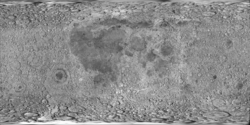Cratere Auzout

| Cratere Auzout | |
|---|---|
| Tipo | Crater |
| Satellite naturale | Luna |
 | |
| Dati topografici | |
| Coordinate | 10°12′36″N 64°00′36″E |
| Maglia | LQ-13 (in scala 1:2.500.000) LAC-62 Mare Undarum (in scala 1:1.000.000) |
| Diametro | 32,9 km |
| Localizzazione | |
Auzout è un cratere lunare di 32,92 km situato nella parte nord-orientale della faccia visibile della Luna.
Il cratere è dedicato all'astronomo francese Adrien Auzout.
Crateri correlati
[modifica | modifica wikitesto]Alcuni crateri minori situati in prossimità di Auzout sono convenzionalmente identificati, sulle mappe lunari, attraverso una lettera associata al nome.
| Auzout | Coordinate | Diametro (in km) |
|---|---|---|
| C[1] | 8°47′24″N 65°16′12″E | 16,86 |
| D[2] | 9°21′00″N 62°25′48″E | 11,66 |
| E[3] | 9°34′12″N 60°39′36″E | 17,36 |
| L[4] | 8°20′24″N 61°18′00″E | 7,5 |
| R[5] | 8°42′00″N 60°02′24″E | 7,68 |
| U[6] | 9°23′24″N 61°03′00″E | 8,15 |
| V[7] | 9°20′24″N 61°18′36″E | 7,82 |
Note
[modifica | modifica wikitesto]- ^ (EN) Auzout C, su Gazetteer of Planetary Nomenclature, United States Geological Survey. URL consultato il 13 giugno 2020.
- ^ (EN) Auzout D, su Gazetteer of Planetary Nomenclature, United States Geological Survey. URL consultato il 13 giugno 2020.
- ^ (EN) Auzout E, su Gazetteer of Planetary Nomenclature, United States Geological Survey. URL consultato il 13 giugno 2020.
- ^ (EN) Auzout L, su Gazetteer of Planetary Nomenclature, United States Geological Survey. URL consultato il 13 giugno 2020.
- ^ (EN) Auzout R, su Gazetteer of Planetary Nomenclature, United States Geological Survey. URL consultato il 13 giugno 2020.
- ^ (EN) Auzout U, su Gazetteer of Planetary Nomenclature, United States Geological Survey. URL consultato il 13 giugno 2020.
- ^ (EN) Auzout V, su Gazetteer of Planetary Nomenclature, United States Geological Survey. URL consultato il 13 giugno 2020.
Altri progetti
[modifica | modifica wikitesto] Wikimedia Commons contiene immagini o altri file sul Auzout
Wikimedia Commons contiene immagini o altri file sul Auzout
Collegamenti esterni
[modifica | modifica wikitesto]- (EN) Cratere Auzout, su Gazetteer of Planetary Nomenclature, United States Geological Survey.
- (EN) Immagini del Cratere Auzout, in Atlante fotografico orbitale della Luna, Lunar and Planetary Institute.

